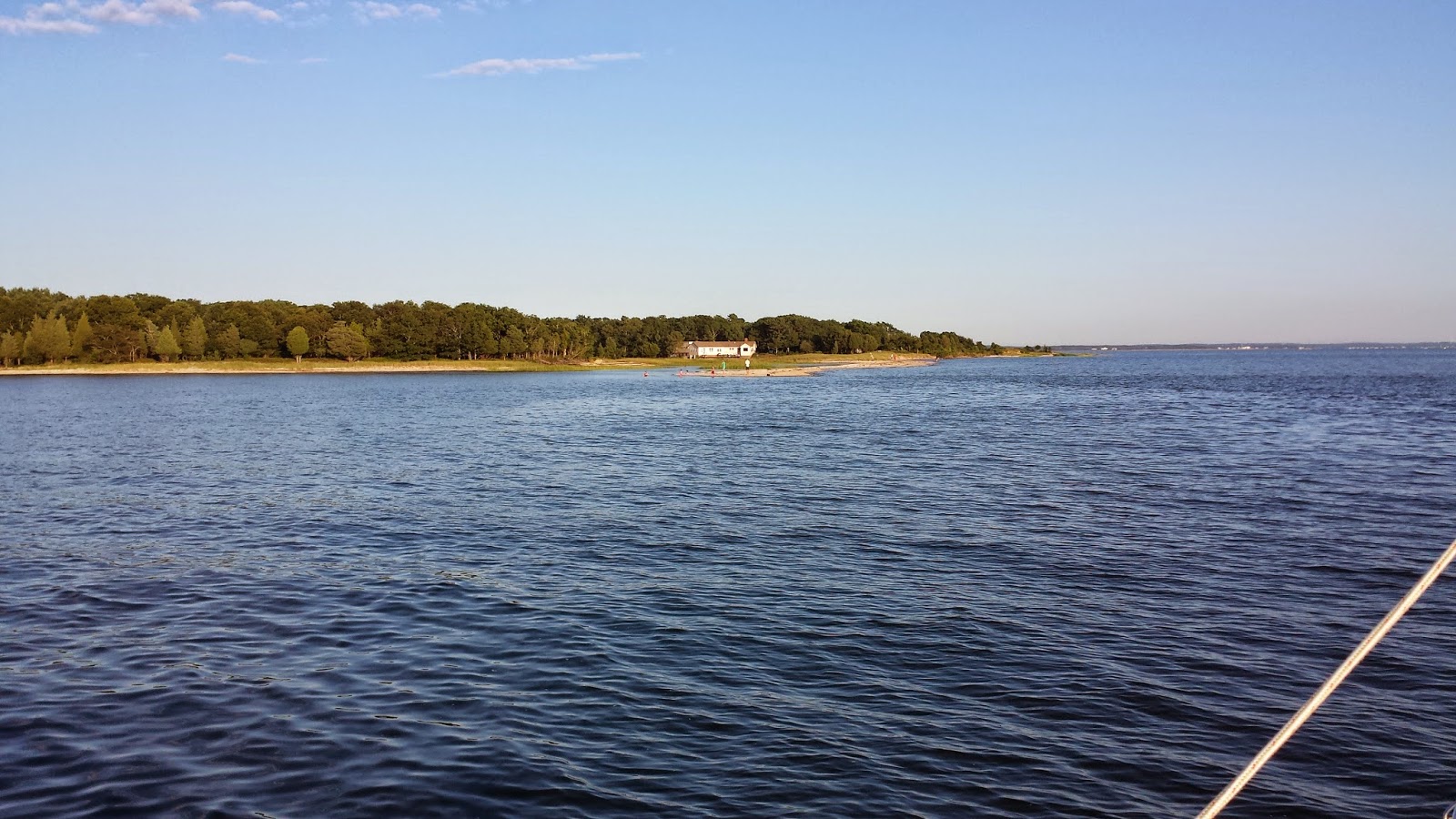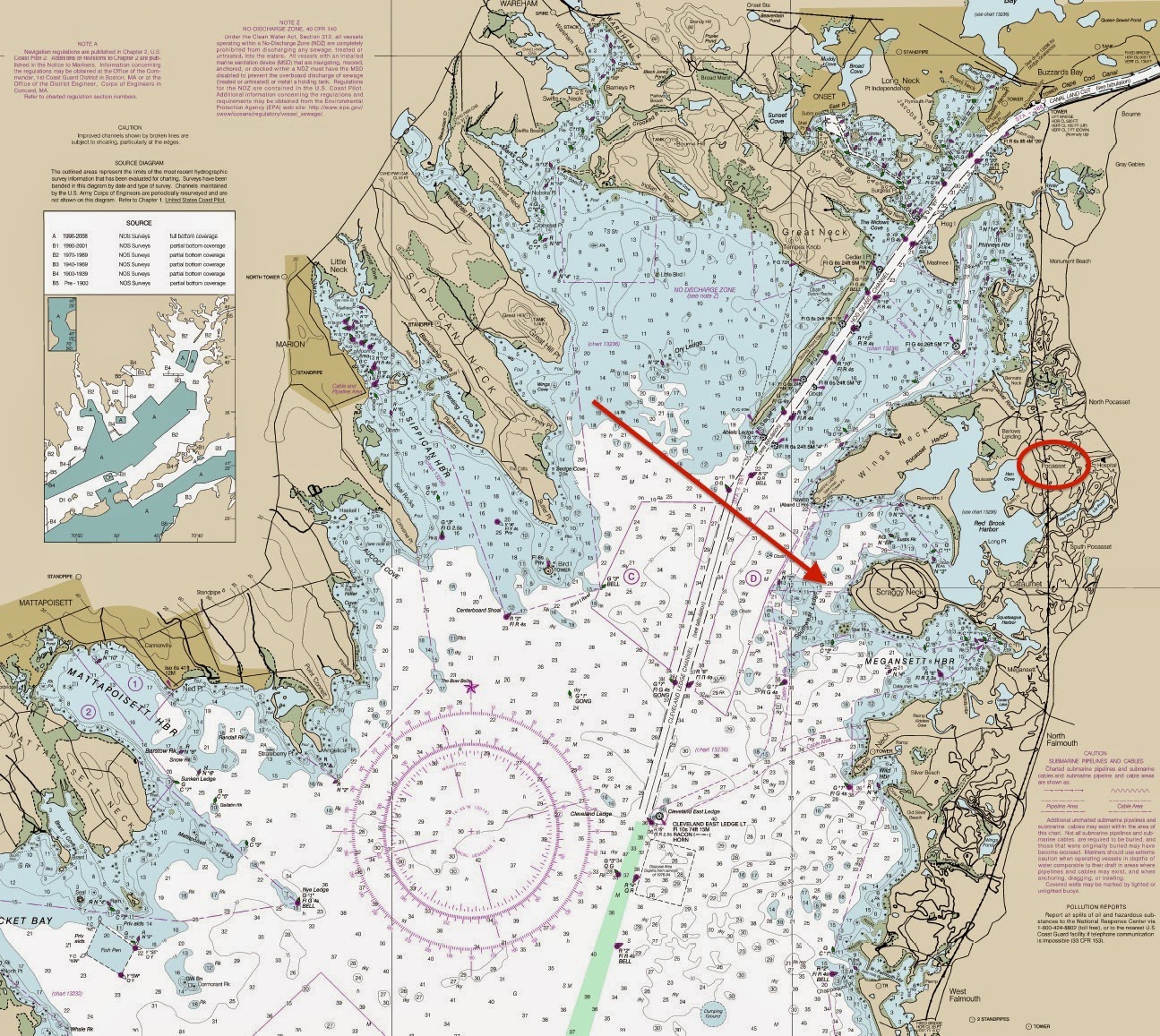In the days following my Pocasset sail, I went out a number of times both alone and with friends, smugly hoisting my mainsail all the way to the top of the mast by muscling it with the winch. Arrrr, Matey, I was becoming a sailor.
Avast! One afternoon I went out to the boat and noticed that the two of the four screws that hold the boomvang to the mast had been pulled out of the mast and were dangling in the screwholes on the boomvang fitting. The boomvang, for those who know less than I do about sailboats, is a device that uses ropes and pulleys to keep the boom from rising when the mainsail is set.
The boomvang runs from the underside of the boom to the base of the mast
It seems Mr. Three Stripes had been neglecting to release the boomvang prior to raising the mainsail. In effect, the taut boomvang prevented the sail from rising all the way up to its fully deployed position. Ooops. So, after all, it was not a fouled block or line at the masthead; nor was it that the boatyard guys rigged it improperly during launch; nor was it that the previous owner was aware of some problem but fiendishly conspired to keep it secret from me. It was all my fault. Gilligan.
Boomvang closeup, showing the screws that I tore out of the mast base with the winch (A),
and the line that should be released prior to hoisting the mainsail (B)
The tension of the winch-load had stretched and slightly warped the boomvang fitting at the mast base, and the two upper screws had been stripped from their holes in the mast. I had to replace the screws with the next size up because all that pulling had enlarged the holes into which they should be secured. Fortunately, it was a minor and easy fix, but I could have made a big mess of things if I hadn't diagnosed the problem correctly before I created real trouble.
By mid-August a new and chronic problem had arisen: bird shit. There are a fair number of birds -- mostly gulls, terns, cormorants -- that frequent Dexter's Cove to feast on the little minnows and other fish that team in the quiet waters of the mooring field. At low tide, the rocks that protect the inlet lay exposed and the birds often rest there, as evidence in their white graffiti.
Mooring at low tide, with the rocky shoal exposed just behind the stern of Piao
Mooring at high tide, with the rocks submerged
When the rocks are underwater, the birds look for other places to land. They ignored my boat throughout May, June, and July. But in August they have become frequent and unwelcome visitors, apparently having taken a shine to my boat as a great place to defecate: 'I like it here so much I could just shit.' Each time I came out to the boat, there would be a half-dozen or more splatters on the deck and in the cockpit. Some were thin white puddles that washed away easily but left lingering stains; others were hardened dribbles that resembled cement spilled on the deck; a few were large and substantive, containing enough meaty remains to make an educated guess about what the bird had eaten. It was nasty. In three weeks, I went through two bottles of boat soap just cleaning up after my unwanted visitors. Then the other day, there were so many turd-bombs that I had no choice but to bring the boat over to the dock in order to hose it down and scrub it properly.
Piao at Dexter's Dock
(Did that maneuver single-handedly, by the way.
Sometimes it is easier simply to do things on one's own, rather than try to get an
opinionated Admiral to listen to instructions about which lines should be cleated where)
People have different strategies for dealing with the bird shit threat. You can buy plastic owls and set them on your boat, hoping that the 'natural predator' will scare the birds away. But you have to move those owls every day or the birds get wise to you. I have heard tales of people returning to their boat to find the plastic owl covered in bird shit. They also sell plastic snakes, but Dylan is deathly afraid of serpents, and it is hard enough to get him on the boat anyways these days. Some of my mooring neighbors have 'gull-sweep' type devices consisting of a horizontal bar with little red tabs that is affixed to the roof of the boat and spins or rotates in the wind. But they have powerboats, whereas I do not want to screw the mounting base of such a device onto the roof of my cabin because one often needs to walk or step there. Then some friends told me that I could get 'gull-sweep' devices (or something functionally similar) that mount on the deck rails fore and aft. That is on my shopping list. In the meantime, I have rigged a rudimentary air defense system for Piao using clothes pins and fishing line.
Piao air defense system
This is an old trick that can work wonders. They use fishing line at some marinas to prevent birds from landing (and shitting) on docks and railings. I spent almost an hour tying fishing line to clothes pins and then stringing the line back and forth across the boat, a few inches above the deck.
As twilight approaches, our ambush is set and ready:
look carefully and you will see fishing line strung criss-crossed above the deck
I worried that the first time I take down all that line and pins, it will become a hopelessly tangled mess. But I was proud of my makeshift solution, which effectively covered all areas of the deck where the birds had been crapping. If I ever put it up again, I will have to remember to start at the bow and work aft toward the cockpit. Otherwise, one must step carefully between the criss-crossing fish line, in 'Mission Impossible' fashion, lest one trip and fall. I had just finished and opened a ice-cold beer to relax and enjoy my accomplishment when....
SPLAAAAAAAAAAAAAAAAAT!
If, as the Chinese say, it is good fortune for a bird to shit on you,
then I am buying lottery tickets this weekend.
An enormous diarrhea bird turd sprayed all over the cockpit, splattering on the cockpit port coaming, the cleat, the winch, my beer, my bag, my shirt, my arms, and my face with bird shit. At first I was stunned and did not know what had happened. I honestly thought it had suddenly started to rain. But then I saw the devastation, and then I smelled the rich fishy scent of the poop. Then I looked up and saw the little fncker -- a big-ass cormorant -- sitting atop my masthead. I swear he was looking down on me, completely oblivious to my shouting and gesticulating. If I had had a gun, I might have tried to shoot him. But all I had was the halyard, which I jangled violently to chase him away. I had to empty my cooler bag of ice melt water, along with four water bottles, to clean his smelly mess. I was pissed. It was very hot and humid, and after all that work I had only that one beer with me. I drank it anyway, flavor added. Finally, I climbed down into the dinghy and rowed toward the dock. But as I pulled away from Piao, I saw that the cormorant had returned to occupy his perch atop the masthead.
You sonuvabitch....
I used to like cormorants. Visitors to China can see fishermen on rafts using the birds to catch fish. The birds are tethered to the boats on long straps. They dive into the water to pursue fish. A removable ring affixed to their neck prevents them from swallowing the fish completely. Instead, as they return to the raft, the fisherman massages the bird's neck and forces it to regurgitate the fish into a collection basket. No hook, line, pole, or bait required.
Fishing with cormorants in Guilin, China
(credit: http://www.shelleylake.com)
So I have eaten fish caught by cormorants, and I have tasted fish-bits shat out by cormorants into my beer. Now I wonder what cormorant meat tastes like......






















































